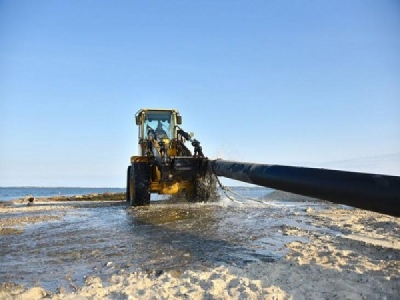
Posted on October 11, 2018
When it comes to sucking a layer of sand and silt off the floor of Lake Tashmoo and moving it to a nearby beach, the men of the Edgartown dredge crew each have a job. Peter Jackson operates the anchor boats, hauling up the dredge’s two anchors and moving them incrementally up and down either end of the channel as the dredge makes its way along the beach.
Greg Bettencourt is in charge of operating a front end loader on the east side of the channel where the sand and mud are deposited.
And Donnie Benefit drives the dredge. Last Monday morning he sat in the cockpit, sunglasses on. Country music played on the radio. Work gloves sat piled on a shelf. He pointed to the screens and gauges with trembling needles.
“This one’s telling me how fast my sand is going in the pipe. That one’s telling me how much sand I’m vacuuming. This one tells me how much pressure I’m discharging,” he said. “It’s a dump truck every six and a half minutes right now.”
At 7:30 that morning, the three had boarded a white anchor boat docked at the Tashmoo landing. Mr. Bettencourt steered them out into the saltwater lake, then north toward the channel for the first full day of dredging.
Tisbury has hired the Edgartown dredge crew for an emergency job in the Tashmoo channel, which was overdue for dredging and had become badly shoaled this summer, causing consternation among boaters, including those who make their living on the water.
The project is expected to be complete by mid-October.
Greg Bettencourt sets the pipe. — Jeanna Shepard
In addition to the costs of getting the dredge to and from Tashmoo, Tisbury will pay Edgartown $7,500 per day for the job, capped at $165,000.
Wearing a dark Carhartt jacket, cigarette in hand, Pete Jackson said he was part of the original crew when Edgartown first purchased a dredge, but then he took a few years off. He rejoined the crew last year.
“I got talked into it I guess,” he said with a chuckle, sipping his coffee.
Mr. Bettencourt works as a landscaper for most of the year and works with the crew in the off-season.
“It keeps me busy in the wintertime,” he said as he steered the boat. “Out of trouble.”
Mr. Benefit, de facto captain of the team, is a conch fisherman.
The dredge was at the far end of the lake, at the entrance bordered by two jetties. The floating machine was crouched like a grasshopper, with two spuds on the back end like hindquarters.
Actually getting the dredge to Tashmoo had proved to be half the battle. It had to be lifted by a rented crane into Katama Bay the week prior, an all-day operation that alone cost $10,000. Then it was towed by a Packer barge from Memorial Wharf to Tashmoo. That trip took several hours and cost $4,000, according to the two-town dredging agreement. Mr. Benefit hauled the 1,200-foot plastic dredge pipe himself in his boat Payback.
On Monday morning Mr. Benefit steered the proboscis-like suction pipe back and forth, using the studs on the back of the dredge to help him rotate. “Those are my walking sticks,” he said. Steel wires connected to the two anchors helped him direct the cutter head.
The floor vibrated. The engine roared. The air smelled of exhaust. He looked up from the levers, button, and dials and saw fisherman Tubby Medeiros’s boat, the Elizabeth Mae, approaching. The boat draws more than four feet. Mr. Benefit would have to maneuver the dredge pipe below the water deep enough for the boat to pass over. Mr. Benefit filled the pipe with sand, sinking it to the channel floor, but it wouldn’t stay there for long.
“Tell him to come on! Come on!” he yelled to Mr. Jackson. “I’m going to have to slow the engine down.” The boat floated slowly by, fishermen waving as they passed.
“The bigger grains of sand settle on the bottom of the pipe,” Mr. Benefit explained. “I have to remove them a little bit so I can suspend the sand again.” That means mixing in water periodically to flush it out.
On the east side of the channel, much of the 1,200-foot plastic pipe lay along the shoreline, slithering out of the water and across the sand to the shore. As a first order of business, Mr. Bettencourt climbed up the ladder into the driver’s seat of the front end loader and used the machine to move the plastic pipe closer to the sea.
Derby fisherman heading out to sea waved as they passed.
Mr. Bettencourt and Mr. Benefit communicated constantly by radio.
“I got a lot of stuff in here right now Greg,” Mr. Benefit’s voice crackled through.
The sediment — and some bewildered minnows — shot through plastic pipe, 12 inches in diameter, and flowed toward the ocean. Gulls landed in the stream to snap up the feast of tiny creatures caught in the flow, unperturbed and unquestioning about this cumbersome, distinctly human operation.
Source: Vineyard Gazette





